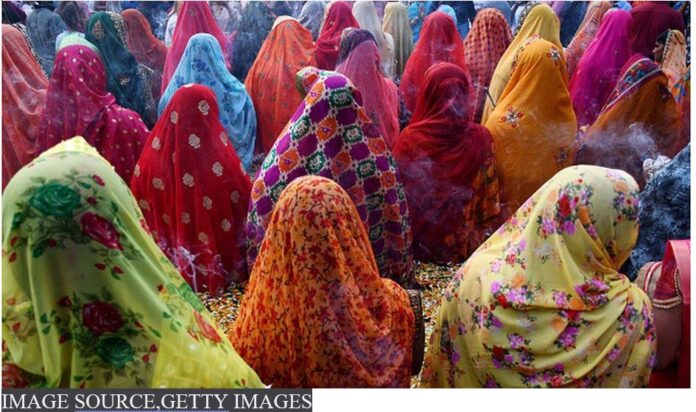Every year 22,265 housewives commit suicide in India, a world record
By Jeph Ajobaju, Chief Copy Editor
Different habits and lifestyles, good and bad, are peculiar to different regions of the world.
In India, the righteous side is delicious cuisine that nourishes the body. The unrighteous side is killing the same body through suicide, for which India has the highest global rates for both men and women.
Every righteous or unrighteous thing done in one country is also done in other countries everywhere on earth; it happens the same way or in different ways.
Something becomes peculiar to a country or a cluster of countries when it is done in a certain way, at a higher rate, and is more widespread in that territory.
Scandinavia – comprising Denmark, Norway, Sweden, Iceland, and Finland – has the best living standards in the world. Generous state welfare, low crime rate. The holy part.
The sin part in the Nordic countries is affinity for nudity. Nudist beaches mingle men and women. In nudist cafes, stark naked servers attend to stark naked customers.
Nigeria is warm. A welcoming place, particularly for foreigners; which is righteous. But Nigeria has a deadly disease called financial corruption, a sin deep in its social and cultural fabric.
The United States acts righteously when it uses its technology to help improve living conditions across the world. However, the US has 120 guns per 100 people, which spur Americans to commit sin by killing one another.
There were 687 mass shootings which led to 44,678 violence deaths in the US in 2021, more than double 19,411 in 2020, according to data compiled by Gun Violence Archive (GVA).
Murder by killing someone is a sin (Exodus 20:13; Romans 13:9). Self-murder or suicide is also a sin, as was the case of Judas Iscariot (Matthew 27:3-5; John 17:12).
Murder leads to hell.
“The works of the flesh are evident, which are: adultery, fornication, uncleanness, lewdness, idolatry, sorcery, hatred, contentions, jealousies, outbursts of wrath, selfish ambitions, dissensions, heresies, envy,
“murders, drunkenness, revelries, and the like; of which I tell you beforehand, just as I also told you in time past, that those who practice such things will not inherit the kingdom of God” (Galatians 5:19-21 NKJV).
Nonetheless, an average 22,265 housewives kill themselves every year in India, a rare thing for women to do in such large numbers in any other country. It is reported below by the BBC:
61 housewife suicides per day
According to data released by the government’s National Crime Records Bureau (NCRB), 22,372 housewives took their own lives in India in 2020 – that’s an average of 61 suicides every day or one every 25 minutes.
Housewives accounted for 14.6 per cent of the total 153,052 recorded suicides in 2020 and more than 50 per cent of the total number of women who killed themselves.
And 2020 was not an exception. Since 1997 when the NCRB started compiling suicide data based on occupation, more than 20,000 housewives have been killing themselves every year. In 2009, their numbers rose to 25,092.
Reports always blame such suicides on “family problems” or “marriage related issues”. But what really does drive thousands of women to take their lives?
Mental health experts say a major reason is rampant domestic violence – 30 per cent of all women told a recent government survey that they had faced spousal violence – and the daily drudgery that can make marriages oppressive and matrimonial homes suffocating.
“Women are really resilient, but there’s a limit to tolerance,” says Dr Usha Verma Srivastava, a clinical psychologist in the northern city of Varanasi.
“Most girls are married off as soon as they turn 18 – the legal age for marriage. She becomes a wife and a daughter-in-law and spends her entire day at home, cooking and cleaning and doing household chores.
“All sorts of restrictions are placed on her, she has little personal freedom and rarely has access to any money of her own.
“Her education and dreams no longer matter and her ambition begins to extinguish slowly, and despair and disappointment set in and the mere existence become torture.”
_________________________________________________________________
Related articles:
Japan records 2,153 suicides in October, more than coronavirus deaths in entire 2020
Upsurge in ‘smash-and-grab’ crimes across US cities
Suicide in Nigeria rising due to impact of COVID-19 lockdown, says Psychiatrist
__________________________________________________________________
Domestic violence
In older women, says Dr Verma Srivastava, the reasons for suicide are different.
“Many face the empty nest syndrome after the children have grown up and left home and many suffer from peri-menopausal symptoms which can cause depression and crying spells.”
But suicides, she says, are easily preventable and that “if you stop someone for a second, chances are they would stop”.
That’s because, as psychiatrist Soumitra Pathare explains, many Indian suicides are impulsive. “Man comes home, beats up wife, and she kills herself.”
Independent research, he says, shows that one-third of Indian women who take their lives have a history of suffering domestic violence. But domestic violence is not even mentioned in the NCRB data as a cause.
Chaitali Sinha, a psychologist with Bangalore-based mental health app Wysa, says “a lot of women who remain in active domestic violence situations retain their sanity only because of the informal support they receive”.
Sinha, who earlier worked for three years in a government psychiatric hospital in Mumbai, counselling survivors of attempted suicide, says she found that women formed little support groups while travelling in local trains or with neighbours while buying vegetables.
“They had no other avenue to express themselves and sometimes their sanity depended on this conversation they could have with just one person,” she says, adding that the pandemic and the lockdown worsened their situation.
“Housewives had a safe space after the menfolk would leave for work, but that disappeared during the pandemic. In situations of domestic violence, it also meant they were often trapped with their abusers.
“It further restricted their movement and their ability to do things that brought them joy or solace. So anger, hurt and sadness builds over time and suicide becomes their last resort.”
India’s global record of suicides
India reports the highest numbers of suicides globally: Indian men make up a quarter of global suicides, while Indian women make up 36 per cent of all global suicides in the 15 to 39 years age group.
But Pathare, who has researched mental disorders and suicide prevention, says India’s official numbers are a huge underestimate and do not convey the true scale of the problem.
“If you look at the Million Death Study [which monitored nearly 14 million people in 2.4 million households between 1998-2014] or the Lancet study, suicides in India are under-reported by between 30 per cent and 100 per cent.”
Suicide, he says, “is still not talked about openly in polite company – there’s shame and stigma attached to it and many families try to conceal it.
“In rural India, there’s no requirement for autopsies and the rich are known to lean upon the local police to show a suicide as accidental death. And police entries are not verified.”
At a time when India is developing a national suicide prevention strategy, Pathare says the priority must be to fix the quality of data.
“If you look at the numbers of attempted suicides in India, they are laughably low. Anywhere in the world, they are generally four to 20 times [the number] of actual suicides.
“So, if India recorded 150,000 suicides last year [2020], the attempted suicides would have been between 600,000 and six million.”
This, Pathare says, is the first at-risk population that should be targeted for any suicide prevention intervention, but we are hobbled by poor data, he says, with consequences worldwide.
“The United Nations target is to cut down suicides globally by a third by 2030, but in the past year [2020], ours have increased by 10 per cent compared to the previous year [2019]. And reducing it remains a pipe dream.”














